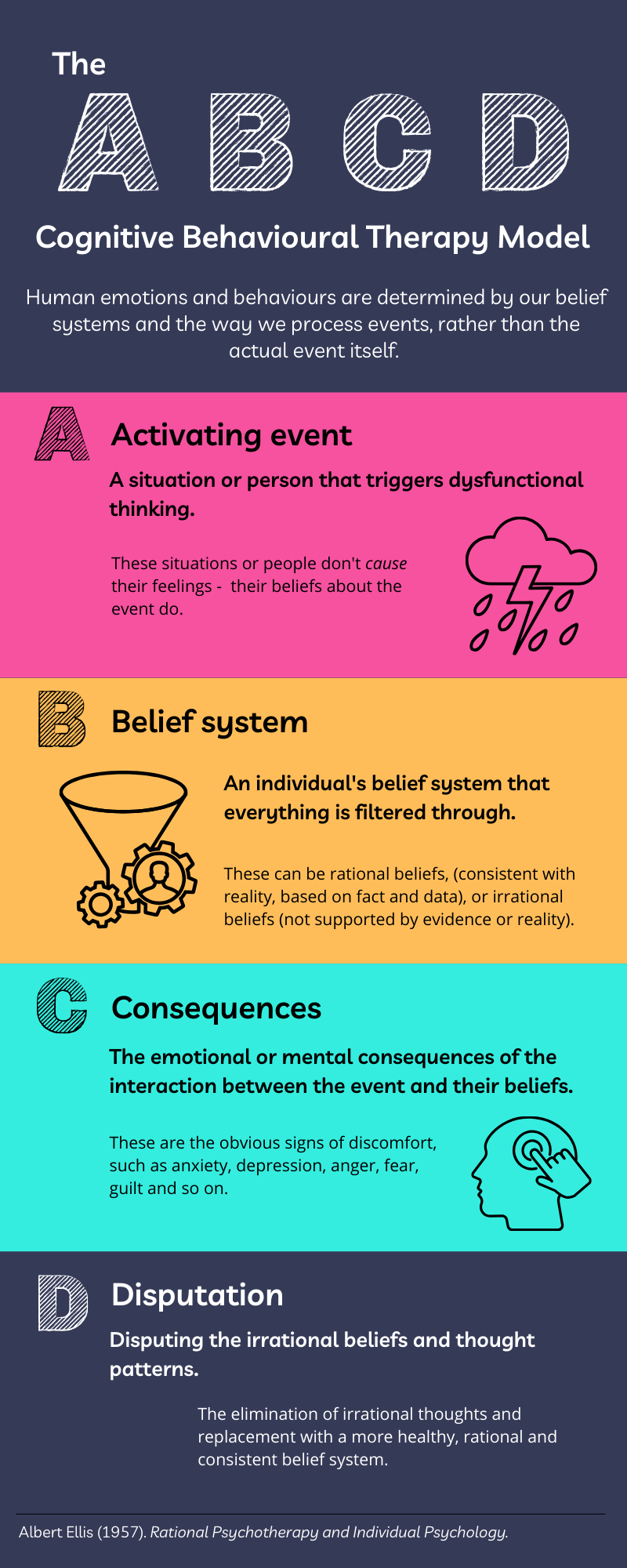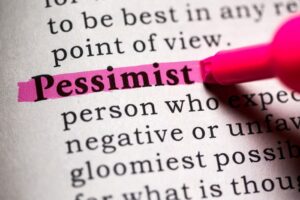Cognitive Behavioral Therapy (CBT) is a powerful tool for managing mental health. It helps people change negative thought patterns and behaviors. The ABC and ABCDE models are key parts of CBT. These models help identify and challenge unhelpful thoughts.
The ABC model stands for Activating event, Belief, and Consequence. The ABCDE model adds two more steps: Dispute and Effect. These models help people spot negative thinking and replace it with more balanced views. They are useful for many mental health issues, including burnout and depressive symptoms.
What Is The ABC Model In CBT?
The ABC model is a key tool in cognitive behavioral therapy (CBT) that helps people understand how thoughts affect emotions and behaviors. It breaks down situations into three parts to show how they connect.
What Does ABC Stand For?
ABC stands for Activating event, Beliefs, and Consequences. The activating event is something that happens to trigger a response. Beliefs are the thoughts and views a person has about the event. Consequences are the feelings and actions that result.
This model helps people see how their thoughts shape their reactions. It shows that events don’t directly cause feelings or behaviors. Instead, it’s the beliefs about those events that lead to emotional and behavioral responses.
CBT uses this model to help people notice and change unhelpful thought patterns. By doing this, they can improve their emotional well-being and reactions to situations.
How Does The ABC Model Work?
The ABC model works by breaking down a situation step-by-step. First, a person identifies the activating event. This could be anything from a small daily hassle to a major life change.
Next, they look at their beliefs about that event. These beliefs might be automatic thoughts that pop up quickly. They can be positive, negative, or neutral.
Finally, they examine the consequences. This includes both emotional responses and actions taken. The model shows how beliefs act as a bridge between events and responses.
By using this model, people can spot unhelpful beliefs. They can then work on changing these beliefs to improve their responses. This process is a core part of CBT treatment.
Example Of The ABC Model In Action
Let’s look at how the ABC model might work in a real situation.
- Activating event: A person doesn’t get invited to a friend’s party.
- Beliefs: “They must not like me. I’m not good enough to be invited.”
- Consequences: Feeling sad and avoiding social events.
In this example, the lack of invitation is the trigger. The beliefs are negative thoughts about self-worth. The consequences are feelings of sadness and withdrawal from social life.
Using the ABC model, a therapist might help the person challenge these beliefs. They could explore other reasons for not being invited. This might lead to new beliefs like, “Maybe it was a small gathering,” or “I should check if there was a mix-up.”
By changing the beliefs, the person might feel less sad and more likely to reach out to friends. This shows how the ABC model can help people respond to situations in healthier ways.
What Is The ABCDE Model In CBT?
The ABCDE model is a key tool in Cognitive Behavioral Therapy (CBT) that helps people change negative thinking patterns. It builds on the ABC model by adding two important steps.
What Does ABCDE Stand For?
- A stands for Activating Event – something that triggers negative thoughts.
- B is Beliefs – the thoughts and interpretations about the event.
- C means Consequences – the feelings and actions that result.
- D represents Disputation – challenging unhelpful beliefs.
- E is for Effective New Belief – creating healthier thoughts.
This model helps people see how their thoughts affect their emotions and actions. By working through each step, they can spot and change negative thinking habits.
How Does The ABCDE Model Build On The ABC Model?
The ABCDE model adds two crucial steps to the ABC model:
D – Disputation: This step involves questioning negative beliefs. People learn to look for evidence that supports or contradicts their thoughts.
E – Effective New Belief: Here, people create more balanced, realistic thoughts to replace unhelpful ones.
These extra steps turn the model from just understanding thoughts to actively changing them. This makes the ABCDE model more powerful for creating lasting change in thinking patterns.
Example Of The ABCDE Model In Action
A: Jane fails a job interview.
B: “I’m not good enough. I’ll never get a job.”
C: Feels sad and stops applying for jobs.
D: Jane asks herself: “Is this true? Have I ever succeeded before?”
E: “This interview didn’t go well, but I can learn from it and do better next time.”
By using the ABCDE model, Jane shifts from feeling helpless to seeing the situation as a chance to improve. This new outlook helps her stay motivated in her job search.
A study in Dr. Martin Seligman’s book Learned Optimism (1990) found interesting results. Participants who learned the ABCDE method had lower rates of depression and anxiety. After 18 months, only 22% had depression and 7% had anxiety. In the control group, the rates were higher at 32% and 15%.
What Is The Difference Between The ABC And ABCDE Models?
The ABC and ABCDE models are both used in cognitive behavioral therapy. They help people understand and change their thoughts and behaviors. The main difference is that the ABCDE model adds two extra steps.
The ABC model has three parts:
- A: Activating event
- B: Beliefs about the event
- C: Consequences (emotions and behaviors)
The ABCDE model expands on this with two more steps:
- D: Disputing irrational beliefs
- E: Effect of new beliefs
Albert Ellis created the ABC model in the 1950s. He later added the D and E steps to make the ABCDE model. This change helped people challenge their thoughts more effectively.
The ABC model focuses on identifying thoughts and feelings. The ABCDE model goes further by actively changing beliefs. This can lead to better results in therapy.
Both models are useful tools in therapy. The choice between them depends on the person’s needs and the therapist’s approach.
Benefits Of Using The ABC And ABCDE Models
The ABC and ABCDE models offer valuable tools for managing emotions and promoting personal growth. These approaches help people change unhelpful thought patterns and behaviors.
For Emotional Regulation
The ABC and ABCDE models give people a way to handle tough feelings. They teach how thoughts affect emotions. This helps with anger, sadness, and worry.
People learn to spot negative thoughts. Then they can change them to more helpful ones. This leads to calmer reactions.
The models work well for many issues. They help with stress, fear, and low mood. People gain tools to cope better with life’s ups and downs.
For Personal Growth
These models boost self-awareness. They show how beliefs shape actions and results. This helps people make positive changes.
Users learn to question their thoughts. They can spot false ideas that hold them back. This leads to more confidence and success.
The models teach problem-solving skills. People learn to face challenges head-on. They find new ways to reach their goals.
For Practitioners
Therapists and coaches find these models very useful. They offer a clear way to help clients. The steps are easy to teach and use.
The models fit many types of therapy. They work well with CBT, REBT, and other methods. This makes them flexible tools.
Practitioners can track progress easily. They see how clients’ thoughts change over time. This helps show the impact of therapy.
For Coaching
Coaches use these models to help clients reach goals. The tools show how thoughts affect actions. This leads to better choices.
Clients learn to spot unhelpful beliefs. They can then change these to more positive ones. This boosts motivation and success.
The models help with many coaching areas. They work for career, health, and personal growth goals. Clients gain skills they can use long-term.

Step-by-Step Guide To Using The ABC And ABCDE Models
The ABC and ABCDE models offer practical frameworks for understanding and changing thoughts, feelings, and behaviors. These steps help people identify and address unhelpful thinking patterns.
Step 1: Identify The Activating Event
The first step is to pinpoint the specific situation or event that triggered a response. This could be anything from a work deadline to an argument with a friend. It’s important to describe the event objectively, without interpretation.
For example:
- “My boss asked me to stay late at work”
- “I received a low grade on my test”
Being clear about the activating event helps set the stage for the next steps. It’s the foundation for understanding the chain of thoughts and feelings that follow.
Step 2: Recognize Beliefs About The Event
Next, identify the thoughts and beliefs that arise in response to the activating event. These beliefs can be rational or irrational, helpful or unhelpful.
Common types of beliefs include:
- “I must always perform perfectly”
- “I can’t handle difficult situations”
- “Others should always treat me fairly”
It’s crucial to write down these beliefs as they occur, without judging them. This step helps build awareness of thought patterns and their impact on emotions and behaviors.
Step 3: Understand The Emotional And Behavioral Consequences
The third step involves recognizing the emotions and actions that result from the beliefs identified in step 2. Emotions might include anxiety, anger, or sadness. Behaviors could range from avoiding situations to lashing out at others.
Examples:
- Belief: “I’m a failure” → Emotion: Depression → Behavior: Isolation
- Belief: “This is unfair” → Emotion: Anger → Behavior: Arguing
Understanding these connections helps people see how their thoughts influence their feelings and actions. This awareness is key for making positive changes.
Step 4 (For ABCDE): Dispute Unhelpful Beliefs
In the ABCDE model, this step involves questioning and challenging unhelpful beliefs. The goal is to examine the evidence for and against these thoughts.
Questions to ask:
- Is this belief based on facts?
- Are there other ways to view the situation?
- What would I tell a friend in this situation?
This process of disputation helps break down irrational thoughts and paves the way for more balanced thinking. It’s a critical step in changing negative patterns.
Step 5 (For ABCDE): Replace With Effective New Beliefs
The final step in the ABCDE model focuses on developing and adopting more helpful beliefs. These new beliefs should be realistic, balanced, and supportive of well-being.
Examples of effective new beliefs:
- “I did my best, and that’s good enough”
- “Mistakes are opportunities to learn and grow”
- “I can cope with challenging situations”
By replacing unhelpful beliefs with more positive ones, people can experience improved emotional responses and more productive behaviors. This step is about creating lasting change in thinking patterns.
Common Challenges And Tips For Using The Models
Recognizing Automatic Thoughts
Spotting automatic thoughts takes practice. Many people struggle to catch negative self-talk in the moment.
A helpful trick is to keep a thought log for a week. Write down upsetting situations and your reactions. Look for patterns in your thinking.
Try setting reminders on your phone to check in with your thoughts throughout the day. This builds awareness over time.
Pay attention to your mood shifts – they often signal automatic thoughts.
Some common cognitive distortions to watch for:
- All-or-nothing thinking
- Overgeneralization
- Mental filtering
- Jumping to conclusions
Overcoming Resistance To Challenging Beliefs
Questioning long-held beliefs can feel scary. Our minds resist change, even when our thoughts hurt us.
Start small by challenging less intense beliefs first. Build confidence before tackling core issues.
Use evidence to gently test your thoughts. Ask: “What facts support or contradict this belief?” Avoid arguing with yourself. Instead, look at your thoughts with curiosity.
Try the “best friend test.” Would you say these things to someone you care about? If not, your self-talk may be too harsh.
Practicing Consistently
Making cognitive restructuring a habit takes time. Set a daily practice goal, even if it’s just 5 minutes.
Pair it with something you already do, like having coffee.
Use reminders and tracking apps to stay on course. Celebrate small wins to stay motivated.
Be patient – change happens slowly.
Find an accountability partner to check in with weekly. Share your progress and challenges. Having support boosts success rates.
Download Worksheet
The ABC and ABCDE model worksheet help people understand their thoughts and emotions. This tool is useful for managing stress and improving mental health.
Download the ABC Model Worksheet
Fill in each section to explore connections between situations, thoughts, and reactions.
Next, challenge negative thought patterns and develope healthier perspectives.
Regular practice with this worksheet can lead to improved self-awareness and emotional regulation. Many mental health professionals recommend daily use for best results.
Conclusion
The ABC and ABCDE models offer valuable frameworks for understanding and managing thoughts and behaviors.
These approaches help people recognize negative patterns and develop healthier responses.
The structured nature of these models makes them accessible tools for self-reflection and change.
While effective, these models have limitations. They may oversimplify complex situations or emotions. Some individuals might need additional support to fully implement the strategies.
Professional guidance can enhance the use of ABC/ABCDE techniques.
Ongoing practice strengthens the skills learned through these models. Many find it helpful to keep a thought journal or work with a therapist.
Regular use of ABC/ABCDE frameworks can lead to lasting improvements in mental well-being and coping abilities.



